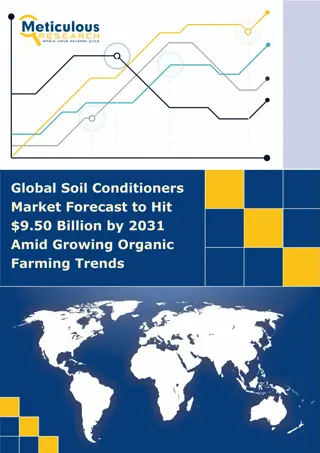Properties and Utilization of Common Polysaccharides in Food Chemistry
Polysaccharides are carbohydrates with more than 10 monosaccharide units, commonly found in foods like starch, cellulose, glycogen, hemicellulose, and pectic substances. Starch, a natural polymer of D-glucose, is a major energy source in the human diet, present in cereals, roots, and tubers. It cons
0 views • 22 slides
Understanding the Integration of Carbohydrate, Lipid, and Protein Metabolism
The integration of metabolism involving carbohydrates, lipids, and proteins can be divided into three stages: hydrolysis to simpler units, preparatory stage, and oxidative stage. In the hydrolysis stage, complex polysaccharides, lipids, and proteins are broken down to simpler forms. The preparatory
3 views • 13 slides
Understanding Qualitative Tests of Carbohydrates
Carbohydrates are vital sources of energy in living organisms and play a significant role in cell structures. This article covers the classification of carbohydrates, including monosaccharides and polysaccharides, and explores their solubility properties. It also delves into the distinction between
0 views • 22 slides
Understanding Carbohydrates: Essential Organic Molecules in Nature
Carbohydrates, also known as saccharides, are crucial organic compounds that serve various functions in living organisms. They are a major energy source, play a role in energy storage, contribute to cell structure, and are essential components of DNA and RNA. Carbohydrates are classified into four g
0 views • 80 slides
Understanding the Hydrolytic Activity of Salivary Amylase on Starch
Enzymes play a crucial role in catalyzing chemical reactions in the human body. This experiment focuses on the hydrolytic activity of salivary amylase on starch, breaking down polysaccharides into intermediate products like maltose. The mechanism of amylase action, types of amylase, and the assay me
0 views • 16 slides
Understanding the Molecular Composition of Living Cells
Living cells are primarily composed of hydrogen, oxygen, nitrogen, carbon, phosphorus, and sulfur, which form the basis of organic biomolecules. Cells have common features such as cytoplasm, cell membranes, and nuclei. Different types of cells exist, ranging from eukaryotic with organized nuclei to
0 views • 9 slides
Understanding Basic Terminology and Classification of Carbohydrates
This lesson covers the fundamental terminology and classification of carbohydrates, including monosaccharides, oligosaccharides, and polysaccharides. Carbohydrates are essential chemical compounds comprising carbon, hydrogen, and oxygen, with diverse classifications based on their structure and comp
0 views • 37 slides
Fiber Content of Various Fruits, Vegetables, and Grains
Explore the fiber content of different fruits, vegetables, and grains based on an estimate of non-starch polysaccharides (old fiber measurement) for 80g servings. The data includes a variety of items such as carrots, apples, oranges, lettuce, mushrooms, broccoli, wholemeal bread, white bread, pasta,
0 views • 6 slides
Understanding Cell Membrane Structure and Proteins
Exploring the basic structure of membranes, the distribution of proteins within the membrane, intrinsic vs. extrinsic proteins, the fluid mosaic model, phospholipids forming the bilayer, the role of hydrophilic and hydrophobic parts in phospholipids, polysaccharides, and the differences between glyc
0 views • 18 slides
Understanding Macromolecules and Energy from Food
Explore the world of macromolecules, including carbohydrates, lipids, proteins, and nucleic acids, and learn how these large molecules are formed from smaller units. Discover the role of carbohydrates in providing energy, digestion, and absorption, and delve into the different types of carbohydrates
0 views • 9 slides
Understanding Carbohydrates: Composition, Structure, and Function
Carbohydrates are composed of carbon, hydrogen, and oxygen in a specific ratio. Monosaccharides such as glucose, fructose, and galactose are carbohydrate monomers, while polysaccharides like lactose, sucrose, starch, cellulose, and glycogen are carbohydrate polymers. The chemical formula for glucose
0 views • 8 slides
Global Soil Conditioners Market Forecast to Hit $9.50 Billion by 2031 Amid Growi
Meticulous Research\u00ae, a global leader in market intelligence, has published a report titled *\"Soil Conditioners Market Size, Share, Forecast, & Trends Analysis by Type (Organic {Polysaccharides}, Inorganic), Solubility (sWater-soluble), Sosil
1 views • 4 slides
Understanding Carbohydrates: A Comprehensive Overview
Carbohydrates are essential organic compounds found abundantly in living organisms, containing carbon, hydrogen, and oxygen. This summary delves into the classification of carbohydrates based on characteristics like the number of carbon atoms, terminal function groups, and the number of sugar subuni
0 views • 5 slides
Understanding Carbohydrates in Science: Structure, Types, and Applications
Explore the comprehensive study of carbohydrates, including their types such as monosaccharides, disaccharides, and polysaccharides. Learn about the molecular structure and functions of cellulose, starch, and other key carbohydrates. Delve into the chemistry of sugars, nucleic acids, and protein syn
0 views • 32 slides
Understanding Polysaccharides: Structure and Function in Chemistry
Polysaccharides are complex carbohydrates made up of multiple monosaccharide units linked by glycosidic linkages. Examples include starch, cellulose, and glycogen. Starch, a major plant carbohydrate, consists of amylose and amylopectin. Amylose forms a linear structure, while amylopectin is highly b
0 views • 13 slides
Understanding Carbohydrates: Qualitative Tests and Classification
Carbohydrates serve as a crucial energy source and structural element in living organisms. This lab explores the qualitative tests and classification of carbohydrates, including monosaccharides, disaccharides, oligosaccharides, and polysaccharides. Learn about the properties and distinctions of diff
0 views • 13 slides
Global Soil Conditioners Market Forecast to Hit $9.50 Billion by 2031 Amid Growi
Meticulous Research\u00ae, a global leader in market intelligence, has published a report titled *\"Soil Conditioners Market Size, Share, Forecast, & Trends Analysis by Type (Organic {Polysaccharides}, Inorganic), Solubility (Water-soluble), Soil Ty
1 views • 4 slides
Soil Conditioners Market to Be Worth $9.50 Billion by 2031
Soil Conditioners Market Size, Share, Forecast, & Trends Analysis by Type (Organic {Polysaccharides}, Inorganic), Solubility (Water-soluble), Soil Type (Loam, Sand, Silt, Peat), Crop Type (Grains & Cereals, Fruit & Vegetables) \u2014 Global Forecast
1 views • 4 slides
The Medicinal Benefits of Aloe: A Comprehensive Overview
Aloe Vera and Aloe Arborescens are just two of hundreds of aloe species known for their medicinal properties. From treating bowel disorders to cancer, aloe has been used for various health conditions. Polysaccharides like Acemannan and components like Emodin and Sitosterol contribute to aloe's heali
1 views • 8 slides


















